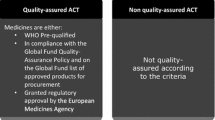Abstract
Artemisinin combination therapies (ACTs) have been recommended for the treatment of malaria in countries where there is widespread resistance to commonly used antimalarial drugs. Several sub-Saharan African countries are, therefore, in the process of introducing ACTs in their malaria drug policies. However, there is limited information about the safety of ACTs outside South East Asia, where their use has been well documented. As with all other new medicinal compounds, the monitoring of a drug’s safety or ‘pharmacovigilance’ is important, especially in areas where co-morbid conditions, such as HIV/AIDS, malnutrition and tuberculosis, are common. Because in most malaria endemic countries, particularly Africa, there are no pharmacovigilance programmes in place, it has been suggested that the introduction of ACTs offers an opportunity for these countries to put drug safety monitoring systems in place. Backed by the WHO Roll Back Malaria department and other international cooperating partners, five African countries, which are in the process of introducing ACTS (Burundi, Democratic Republic of the Congo, Mozambique, Zambia and Zanzibar) have drawn up action plans to introduce pharmacovigilance in their health sector. It is planned that once the safety monitoring of antimalarials has been established, these activities can then be extended to cover medicinal compounds used in other public health programmes, such as HIV/AIDS, tuberculosis and the immunisation programmes. This article looks at the rationale for pharmacovigilance, the process of setting up monitoring centres and the challenges of implementing the project in the region.



Similar content being viewed by others
References
Kachu SP, Bloland PB. Malaria. In: Wallace RB, editor. Maxcy-Rosenau textbook of public health and preventive medicine. 14th ed. Stamford (CT): Appleton and Lange, 1978: 313–48
Kevin Baird J. Resurgent malaria at the millennium: control strategies in crisis. Drugs 2000; 59(4): 719–43
Bruce-Chwatt LJ. Essential malariology. London: Heinemann Medical Books, 1980
MacDonald G. The epidemiology and control of malaria. London: Oxford University Press, 1957
Campbell CC, Chin W, Collins WE, et al. Chloroquine resistant Plasmodium falciparum from East Africa: cultivation and drug sensitivity of the Tanzanian I/CDC strain from an American tourist. Lancet 1979; II: 1151–4
Bruce-Chwatt LJ, editor. World Health Organization Monograph Series, No. 27. Geneva: World Health Organization, 1981
World Health Organization. The Africa malaria report, 2003 (WHO/CDS/MAL/2003.1093). Geneva: World Health Organization and UNICEF, 2003
World Health Organization. The African summit on Roll Back Malaria, Abuja, Nigeria, 25th April 2000 (document WHO/CDS/RBM/2000.17). Geneva: World Health Organization, 2000
Stahel E, Degremont A, Lagler U. Pyrimethamine/sulfadoxine resistant falciparum malaria acquired at Dar Es Salaam, Tanzania. Lancet 1982; I: 1118–9
Timmermans PM, Hess V, Jones ME. Pyrimethamine resistant falciparum malaria in East Africa. Lancet 1982; I: 1181
World Health Organization. Framework for implementing and updating antimalarial treatment policy in Africa: a guide for malaria control programmes. Harare: World Health Organization Regional Office for Africa, 2000
World Health Organization. The use of essential drugs. Geneva: World Health Organization, 2000. WHO technical report series no. 895
Hien TT. An overview of the clinical use of artemisinin and its derivatives in the treatment of falciparum malaria in Vietnam. Trans R Soc Trop Med Hyg 1994; 88Suppl. 1: S5–6
Hien TT, Day NP, Nguyen HP, et al. A controlled trial of artemether or quinine in Vietnamese adults with severe falciparum malaria. N Engl J Med 1996; 335: 76–83
van Hensbrook MB, Onyiorah E, Jaffar S. A trial of artemether or quinine in children with cerebral malaria. N Engl J Med 1996; 335(2): 69–75
Price R, van Vogt M, Phaipum L, et al. Adverse effects in patients treated with artemisinin derivatives. Am J Trop Med Hyg 1999; 60(4): 547–55
Ribeiro IR, Olliaro P. Safety of artemisinin and its derivatives: a systematic review of published and unpublished clinical trials. Med Trop (Mare) 1998; 58: 50–3
Stephens M, Talbot JCC, Routledge PA. Detection of new adverse drug reactions. 3rd ed. London: Macmillan Reference Ltd, 1998
World Health Organization. The importance of pharmacovigilance: safety monitoring of medicinal products. Geneva: World Health Organization, 2002
World Health Organization. International drug monitoring: the role of the hospital. Geneva: World Health Organization, 1966. WHO technical report series no. 425
Uppsala Monitoring Centre. Safety Monitoring of Medicinal Products: guidelines for setting up and running a Pharmacovigilance Centre. Uppsala: The Uppsala Monitoring Centre, 2000
Olsson S. The role of the WHO Programme on International Drug Monitoring in coordinating world wide drug safety efforts. Drug Saf 1998; 19(1): 1–10
British Medical Association. Royal Pharmaceutical Society of Great Britain. British National Formulary (No. 45). London: BMA, RPS, 2003
Uppsala Monitoring Centre. Dialogue in pharmacovigilance: more effective communication. Uppsala: The Uppsala Monitoring Centre, 2000
Einarson TR. Drug related hospital admissions. Ann Pharmacother 1993; 27: 832–40
Bates DW, Cullen DJ, Laird N, et al. Incidence of adverse drug events and potential adverse drug events, implications for prevention. JAMA 1995; 274: 29–34
Bates DW, Spell N, Cullen DJ, et al. The cost of adverse events in hospitalised patients. JAMA 1997; 277: 307–11
Classen DC, Pestonik SL, Evans RS, et al. Adverse events in hospitalized patients: excess length of stay, extra costs and attributable mortality. JAMA 1997; 277: 301–6
Pirmohamed M, Breckenridge AM, Kitteringham NR, et al. Adverse drug reactions BMJ 1999; 316: 1295–8
Lazarou J, Pomeraz BH, Corey PN. Incidence of adverse drug reactions in hospitalized patients, a meta analysis of prospective studies. JAMA 1998; 279: 1200–5
Moore N, Lecointre D, Noblet, et al. Frequency and cost of serious adverse drug reactions in a department of general medicine. Br J Clin Pharmacol 1998; 45: 301–8
Government of Zambia. National Drug Policy. Lusaka, Zambia: Ministry of Health, 1999
Uppsala Monitoring Centre. Uppsala Reports. Uppsala: Uppsala Monitoring Centre, 2004 Jan
Acknowledgments
Dr O. Simooya served as consultant to the WHO in the early phase implementation of the pharmacovigilance project. No sources of funding were used to assist in the preparation of this study.
Author information
Authors and Affiliations
Corresponding author
Rights and permissions
About this article
Cite this article
Simooya, O. The WHO ‘Roll Back Malaria Project’. Drug-Safety 28, 277–286 (2005). https://doi.org/10.2165/00002018-200528040-00001
Published:
Issue Date:
DOI: https://doi.org/10.2165/00002018-200528040-00001




